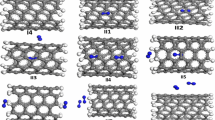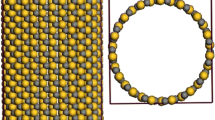Abstract
We have investigated the hydrogen energy storage potentials of (8, 8) single-walled carbon nanotubes (SWCNTs) and (8, 8) single-walled boron nitride nanotubes (SWBNNTs) using density functional theory. Calculations of the electronic properties of the studied systems were performed using the Perdew, Burke and Ernzerhof (PBE) exchange correlation function of the generalized gradient approximation. The optical adsorption response of the pure and hydrogen-adsorbed systems was determined within G0W0 approximations with both RPA and BSE. From the obtained results, it was found that both (8, 8) SWBNNT and SWCNT were stable when the hydrogen molecule was 8.72 m away from the adsorption surface. SWBNNT was found to show stronger adsorption from 5 to 15 eV, which is in the UV range. On the other hand, SWCNT adsorbs hydrogen in the 0–5 eV which falls in the UV–Vis range, with higher adsorption recorded from 0 to 2.4 eV, which corresponds to the visible range. Although both systems adsorb hydrogen, (8, 8) SWCNT is reported to be better than (8, 8) SWBNNT due to its ability to adsorb in the visible region of the electromagnetic spectrum. Therefore, SWCNT is regarded as a better candidate for hydrogen energy storage under ambient conditions.










Similar content being viewed by others
Data availability
All data used in this work were contained in the manuscript.
References
Frederica, P.: Pollution from fossil-fuel combustion is the leading environmental threat to global pediatric health and equity: solutions exist. Int. J. Environ. Res. Public. Health 15, 16 (2018)
Caren, G., Renee, N., Debra, M., Chana, A., Thomas, H.: Fossil-fuel pollution and climate change—a new nejm group series. N. Engl. J. Med. 386, 2328–2329 (2022)
Frederica, P., Kari, N.: Climate change, fossil-fuel pollution, and children’s health. N. Engl. J. Med. 386, 2303–2314 (2022)
Orazi, V., Ambrusi, R.E., Marchetti, J.M., Pronsato, M.E.: DFT study of the hydrogen adsorption and storage on Ni4 cluster embedded in multivacancy graphene. Int. J. Hydrog. Energy 45(55), 30805–30817 (2020)
Yang, S., Wang, X., Lei, G., Xi, H., Zhao, W.: A DFT study on the outstanding hydrogen storage performance of the Ti-decorated MoS2 monolayer. Surf. Interfac. 26, 101329 (2021)
Shivaprasad, K.V., Raviteja, S., Parashuram, C., Kumar, G.N.: Experimental Investigation of the Effect of Hydrogen Addition on Combustion Performance and Emissions Characteristics of a Spark Ignition High Speed Gasoline Engine. Procedia Technol. 14, 141–148 (2014)
Pingping, L., Fangming, L., Yuan, P., Qiming, W.: A DFT study of hydrogen adsorption on Ca decorated hexagonal B36 with van der Waals corrections. Phys. E 114, 113576 (2019)
Iqbal, S., Halima, K., Ashiq, H.P., Ahmad, S.: Recent development of carbon based materials for energy storage devices. Mater. Sci. Energy. Technol. 2, 417–428 (2019)
Itas, Y.S., Suleiman, A.B., Razif, R., Aminu, S.Y.: Ab’initio studies of the structural and electronic properties for single-walled armchair MgONT, SiCNTs and ZnONTs for next generations’ optoelectronics. Gadau J. Pure Allied Sci. 1, 160–165 (2022)
Dario, et al.: Turbo charging time-dependent density-functional theory with Lanczos chains. J. Cheml Phys 128, 154105 (2008)
Lawal, A., Shaari, A., Ahmad, R.: First-principles investigations of electron-hole inclusion effects on optoelectronic properties of Bi2Te3, a topological insulator for broadband photodetector. Physica B 520, 69–75 (2017)
Ferdaus, A.J., Mayeen, K.U., Itas, Y.S., Miraz, M.H.: Cancerous and non-cancerous brain MRI classification method based on convolutional neural network and log-polar transformation. Healthcare 10(9), 1801 (2022)
Blase, X., Rubio, A., Cohen, M.L.: Stability and band gap constancy of boron nitride nanotubes. EPL 28, 335 (2014)
Itas, Y.S., Balarabe, A.S., Chifu, E.N., Lawal, A., Mayeen, K.U.: Computational studies of the excitonic and optical properties of armchair SWCNT and SWBNNT for optoelectronics applications. Crystals 12(6), 870 (2022)
Itas, Y.S., Suleiman, A.B., Ebene, C.N., Lawal, A., Razif, R.: The exchange-correlation effects on the electronic bands of hybrid armchair single-walled carbon boron nitride nanostructure. Crystals 12(3), 394–394 (2022)
Arenal, R., Stephan, O., Kociak, M., Colliex, C.: Optical gap measurements of boron nitride nanotubes by EELS. Microsc. Microanal. 12, 1166–1167 (2006)
Lönnecke, K., Eberhardt, O., Wallmersperger, T.: Electrostatic charge distribution in armchair and zigzag carbon nanotubes: a numerical comparison of CNT charge models. Acta Mech 21, 03085–03093 (2021)
Jarvis, S.P., Taylor, S., Baran, J.D., Thompson, D., Saywell, A., Mangham, B., Champness, N.R., Larsson, J.A., Moriarty, P.: Physisorption controls the conformation and density of states of an adsorbed porphyrin. J. Phys. Chem. C 119, 27982–27994 (2015)
Yahaya, S.I., Tasiu, Z., Ebene, C.N.: carbon nanotubes: a review of synthesis and characterization methods techniques. The Int J of Sci and Teck 8(2), 111 (2020)
Jakub, K., Kupka, T., Marzena, J.: DFT studies on armchair (5, 5) SWCNT functionalization. modification of selected structural and spectroscopic parameters upon two-atom molecule attachment. J. Mol. Graph. Model. 55, 105–114 (2015)
Itas, Y.S., Balarabe, A.S., Ebene, C.N., Lawal, A., Razif, R., Mayeen, K.U.: Effects of oxygen absorption on the electronic and optical properties of armchair and zigzag Silicon Carbide Nanotubes (SiCNTs). Phys. Scr. 98, 015824 (2022)
Itas, Y.S., Ebene, C.N., Mayeen, K.U.: Synthesis of thermally stable h-bn-cnt hetero-structures via microwave heating of ethylene under nickel, iron, and silver catalysts. Crystal 11(9), 1097 (2021)
Itas, Y.S., Isah, K.A., Nuhu, A.H., Razali, R., Salisu Tata, K.A., Naseer, A.M., Habib, I.M., Ullah and Mayeen Uddin Khandaker,: The potentials of boron-doped (nitrogen deficient) and nitrogen-doped (boron deficient) BNNT photocatalysts for decontamination of pollutants from water bodies. RSC Adv. 13, 23659–23668 (2023)
Itas, Y.S., Razali, R., Tata, S., Idris, A.M., Khandaker, M.U.: Studies of the hydrogen energy storage potentials of Fe-and Al-doped silicon carbide nanotubes (SiCNTs) by optical adsorption spectra analysis. J. Energy Storage 71, 108534 (2023)
Megan, C.: Eco-friendly hydrogen storage alternative with carbon nanotubes, Nanomaterials, (2022)
Hong, W., Fan, X., Kuo, J., Deng, W.: DFT Study of Hydrogen Storage by Spillover on Graphene with Boron Substitution. J. Phys. Chem. C 115(18), 9241–9249 (2011)
Giannis, M., George, E.F.: Why boron nitride nanotubes are preferable to carbon nanotubes for hydrogen storage?: an ab initio theoretical study. Catal. Today 120(3), 341–345 (2007)
Renzhi, M., Yoshio, B., Zhu, H., Xu, C.: Hydrogen uptake in boron nitride nanotubes at room temperature. J. Am. Chem. Soc. 124(26), 7672–7673 (2002)
George, M., George, E.F.: DFT study of hydrogen storage by spillover on graphite with oxygen surface groups. J. Am. Chem. Soc. 131(42), 15133–15135 (2009)
Fernando, H., Carlos, R.M., Jose, L.H.: Critical analysis on hydrogen as an alternative to fossil fuels and biofuels for vehicles in Europe. Renew. Sustain. Energy Rev. 14, 772–780 (2010)
George, E.F.: Hydrogen storage in nanotubes & nanostructures. Mater. Today 14, 324–328 (2011)
Itas, Y.S., Balarabe, A.S., Chifu, E.N., Lawal, A., Mayeen, K.U., Razif, R.: DFT studies of structural, electronic and optical properties of (5, 5) armchair magnesium oxide nanotubes (MgONTs). Phys E: Low-dimensional Syst Nanostruct. 149, 115657 (2022)
Michael, R.M.: Titanium-decorated boron nitride nanotubes for hydrogen storage: a multiscale theoretical investigation. Nanoscale 11, 16052–16062 (2019)
Acknowledgements
The authors of this work acknowledges Bauchi State University, Gadau—Nigeria, for providing the resource persons and funds for the successful take-off of this research. Federal University Dutse—Nigeria and Universiti Teknologi Malaysia for providing computational condensed matter training to the lead researcher. Furthermore, larger constructive and mentorship efforts by Professor Mayeen Uddin Khandaker of Sunway University Malaysia are well acknowledged.
Funding
The authors extend their appreciation to the Deanship of Scientific Research at King Khalid University for funding this work through a large group research project under grant number (R.G.P.2/324/44).
Author information
Authors and Affiliations
Contributions
Y.S.I. and A.B.S. helped in conceptualization; Y.S.I. and C.E.N. helped in methodology; Y.S.I., C.E.N., R.R. and A.L. worked in software; Y.S.I., I.I.I. and A.B.S. helped in formal analysis; S.M.E., A.A.M. and I.K. worked in resources; M.U.K. and Y.S.I. helped in data curation; Y.S.I. contributed to writing—original draft preparation; M.U.K. contributed to writing—review and editing and M.K, S.T and A.M.I. helped in team revision. All authors have read and agreed to the published version of the manuscript.
Corresponding author
Ethics declarations
Conflict of interest
The authors declare that they have no known competing financial interests or personal relationships that could have appeared to influence the work reported in this paper.
Additional information
Publisher's Note
Springer Nature remains neutral with regard to jurisdictional claims in published maps and institutional affiliations.
Rights and permissions
Springer Nature or its licensor (e.g. a society or other partner) holds exclusive rights to this article under a publishing agreement with the author(s) or other rightsholder(s); author self-archiving of the accepted manuscript version of this article is solely governed by the terms of such publishing agreement and applicable law.
About this article
Cite this article
Itas, Y.S., Suleiman, A.B., Ndikilar, C.E. et al. New trends in the hydrogen energy storage potentials of (8, 8) SWCNT and SWBNNT using optical adsorption spectra analysis: a DFT study. J Comput Electron 22, 1595–1605 (2023). https://doi.org/10.1007/s10825-023-02093-x
Received:
Accepted:
Published:
Issue Date:
DOI: https://doi.org/10.1007/s10825-023-02093-x




